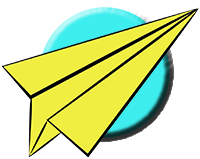How to Fold the Chestnut Paper Airplane
How to Fold the Chestnut Paper Airplane
Instructions
1. Fold the upper left point down so it hits the lower right point.
2. Rotate the paper around so the crease created previously is on the left. Fold the top down so it hits the bottom point.
3. Unfold all of the flaps created previously so the paper is completely open and flat on the working surface.
4. Rotate the paper around so the upper point of the long diagonal fold is to the left. Fold the top point down so it hits the bottom point.
5. Rotate the paper around so the crease created previously is on the right. Fold the top point down so it hits the bottom point.
6. Unfold all of the creases created previously. The paper should be completely open and flat on the working surface.
7. Fold the paper exactly in half along its long edge. Unfold after the crease has been made.
8. Pop the left and right sides of the paper up, bringing them in towards the middle. The upper left and right points should come together to form a new flap sticking straight up from the base of the paper. Two new creases will be formed.
9. Split the layers of the flap apart bringing the points out towards the lower left and right corners of the paper. Bring the point at the top of the flap down to the center of the bottom edge of the paper and press the fold flat.
10. Fold all of the top-most layers of the paper over. The left and right points of the new crease should be at the left and right points on the edges of the paper.
11. Fold the tip of the nose down to the top point formed at the middle of the paper by the existing flaps.
12. Flip the plane over and rotate it around so the nose is to the left.
13. Fold the plane exactly in half along the existing center line crease.
14. Rotate the plane around so the nose is to the right. Make a crease for the first wing flap. The new crease should be parallel to the bottom edge of the fuselage and about one finger width up from the bottom.
15. Flip the plane over so the nose is to the left. Make a crease for the second wing flap. Be sure to line up the wing flaps for good balance and agile flying.
16. Open up the wing flaps and adjust the dihedral wing angles so they are even. Set the angle flat or slightly up. Make sure the front canard wings are tightly creased.
THE THROW: Launch gently at a slight up angle or release to float from a high place. The Chestnut usually needs some adjustments to the tail corners to counteract the weight of the nose section. You can do this by turning the ends up. Bending the canards upwards also tightens them and changes the flight path even more.
